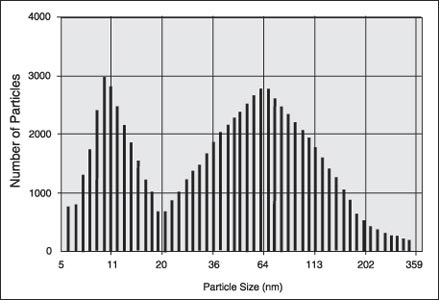| Particle
pollution: Size does matter
By Dr. Rohan Jayaratne
Every millilitre of air that we breathe
contains a few thousand very small, solid particles.
At rest, we inhale about 700 millilitres of air with
every breath. That is over a million particles in every
breath. When the body is exerted, our breathing rate
increases, and the number of particles inhaled may be
up to three times higher.
These atmospheric particles, or aerosols,
originate from a number of natural sources, including
ground dust, sea salt, pollen and volcanic eruptions,
forest fires, as well as from anthropogenic sources
such as motor vehicles, industrial processes and wood
burning.
During recent years, the contribution
to the aerosol budget by human activities has grown
exponentially. Today, it is estimated that the main
source of particulate pollution in urban environments
is from motor vehicles. This poses significant and growing
air pollution and health threats. Standing by the side
of a busy road, a person may inhale about 40 million
particles with each breath. And, if you happen to get
a whiff from the exhaust plume of a passing lorry, that
number could go up by a factor of ten! In some cities,
like Hong Kong, Los Angeles and Mexico City, the situation
has reached such proportions that emergency legislation
is being enforced to arrest the problem.
 |
| Smog over Colombo City |
How serious is the problem
here
Today, we have around 2.5 million
motor vehicles plying 12,000 km of tarred road. This
includes 300,000 cars, 80,000 buses and nearly 250,000
goods vehicles, lorries and vans. Petrol, used in cars
and motor cycles contain lead compounds, which are cumulative
poisons as they slowly build up within the body. Many
countries are now adopting unleaded petrol to mitigate
this problem.
Most of the particulate pollution
comes from medium and heavy duty vehicles that operate
on diesel. Diesel emissions are often seen as thick
black clouds behind vehicles on our roads. These soot
particles are coated with a noxious cocktail of dangerous
chemicals like benzenes, formaldehydes and a particularly
nasty group of chemicals that are classified as polynucleic
aromatic hydrocarbons or PAH’s for short. Also
present are other volatile organic compounds as well
as inorganic compounds like sulfuric acid.
Many of these are known carcinogens
or cancer-causing substances. These dangerous chemicals
coat the particles which are then inhaled deep into
our lungs. Particulate pollution has been consistently
associated with increased cardiovascular and respiratory
diseases and mortality. Although the association is
well established, the mechanisms responsible for these
adverse health effects have not been well-elucidated.
Mass versus size
Standards for emission control are
based on particle mass. That is, there are regulations
that restrict the mass of particle pollution emitted
by a vehicle. For example, currently, European Union
emission standards for heavy-duty vehicles limit particulate
emission to 20 milligrams per kilowatt-hour of energy
expended by the engine.
This may sound technical to the layman;
but the point that I am making is that the legislative
standards are based on particle mass and say nothing
about particle size or number. There is an important
distinction here. Look at the accompanying diagram.
If you put together one thousand small water drops,
they will form a single water drop 10 times larger in
diameter. In other words, the mass of one large water
drop is the same as the combined mass of a thousand
drops ten times smaller in diameter. However in this
example, the combined surface area of the one thousand
small water drops is a hundred times larger than the
surface area of the large drop.
The same thing applies to aerosol
particles. A vehicle may emit a certain mass of particulates
which may consist of either a small number of large
particles or a large number of small particles. Using
a particulate mass sensor to monitor emissions from
two vehicles, we may deduce that Vehicle A is the cleaner
emitter if it emits less particulate mass than Vehicle
B. However, Vehicle A may in fact be emitting many more
particles than Vehicle B. Which then is the ‘cleaner’
vehicle?
Why size matters
The size of a particle is important
in two ways. First, for a given mass of particulates,
a large number of small particles present a much larger
surface area than a small number of larger particles.
This allows a larger surface area for the dangerous
chemicals to adhere to. Secondly, when we inhale, larger
particles are trapped in the nostrils and upper airways
and are prevented from entering our respiratory system.
However, the smaller the particle,
the deeper it can penetrate into our lungs, carrying
any toxic material with them. Once they get in there,
they can cause a lot of adverse health effects, like
pulmonary inflammation. They may provoke the release
of toxic free radicals; and they can even pass through
interstitial layers to enter the bloodstream. Leaving
aside the technical jargon, all it means is that they
can do a whole lot of damage to your health!
Diesel particles
The diagram shows what we call a number-size
distribution of the particles present in the emissions
from a diesel bus. The number of particles is shown
as a function of particle size, which is given in nanometers
(nm). A nanometer is a millionth of a millimetre. Gas
molecules are a tenth of a nanometer to 1 nm in diameter,
while virus particles are a few tens of nanometers across.
Typical vehicle emission particles range in size from
a few nanometers to a hundredth of a millimetre. Most
of the soot particles that we see are a few hundred
nanometers in size.
 |
The diesel particle size distribution is bi-modal, that
is it has two peaks. The peak on the right, at about
60 nm is composed of black carbon soot. Note the second
peak that occurs at smaller sizes, at around 10 nm.
This second peak is often observed when a vehicle is
accelerating hard or labouring under a heavy load. A
substantial number of the total particle count is found
here, and they are known as nanoparticles. They are
too small to be seen with the naked eye.
The existence of nanoparticles in
vehicle emissions was not known until recently, after
scientists had developed instrumentation that could
measure such small particles.
Today we can measure nanoparticles
in the air down to a size of about 1 nm.
Because of their small size, nanoparticles
do not contribute substantially to the total mass of
particulates and they can go largely undetected by instruments
that measure particulate mass. As vehicle emission standards
are governed by particulate mass, they are not controlled
by legislation. Nanoparticles easily pass through conventional
face masks and filters designed to trap germs and viruses.
They penetrate deep into the human lungs and cause adverse
health effects that are of increasing concern to environmentalists
and the medical profession.
For this reason, some countries, notably
Switzerland, are today advocating strict emission control
guidelines incorporating particle number and size, to
complement existing measures to control emissions of
particulate mass.
(The writer is attached
to the International Laboratory of Air Quality and Health,
School of Physical Sciences, Queensland
University of Technology, Brisbane, Australia, and
has been working on environmental related research for
many years) | 